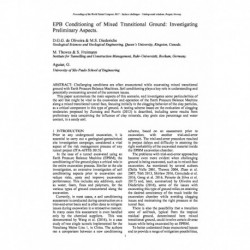No document
Search & filter
Search for a publication
Search & filter
List of products by author: M. S. Diederichs
-
A DFN-LiDAR-optical sensor method for the estimation of rockmass conditions in underground projects
Abstract: A sound and economical underground project design depends on a realistic geological model, a quality rockmass characterization and an informed assessment of other influencing factors. However, due to the lack of truly three-dimensional subsurface fracture geometry data, this reality is rendered difficult. In order to overcome this, the use of Discrete Fracture Networks (DFNs) is becoming...
0,00 € -
Application of Composite Geological Strength Index for healed rockmass structure to deep mine access tunnels
Abstract: Rockmass characterization is an essential process for pre-construction geotechnical engineering design for underground excavations that requires an assessment of the macro-scale rockmass structure (interblock structure) and micro-scale intact rock strength to quantify rockmass behaviour. In complex rockmasses, meso-scale healed structure such as hydrothermal veins (intrablock structure) exists...
0,00 € -
Applications of Acoustic Mechanical Property Analysis in Deep Tunnelling Operations Under High Stress
Abstract: One of the challenges of deep tunnelling through hard rock is the prediction of violent brittle failure along a blind alignment. In addition to high in-situ stress, geologic structures including faults, veins, and alteration zones cause stiffness transitions which can localize stress. The application of mechanical property assessment, using acoustic velocity measurement both at borehole scale...
0,00 € -
Behavioral uncertainty for rock tunnels: Implications for rockmass definitions or predictions in geotechnical...
Abstract: On North American tunneling projects, uncertainty surrounding the expected ground conditions presented in the geotechnical baseline report (GBR) often results in conservative GBRs or an abundance of contractor differing site condition (DSC) claims. Rockmass behavior in GBRs is typically presented with rockmass classification systems or with a number of rockmass behavior classes. This paper...
0,00 € -
Challenges in characterization of complex rockmasses, using drillcore, as input into geomechanical analysis for...
Abstract: Rockmass characterization is an essential component of geotechnical design for tunnels and other underground excavations. The nature of data collected for conventional geotechnical characterization of drill core is often directed by inputs for empirical rockmass classification systems, but advanced numerical models require more sophisticated data for geotechnical designs in complex rockmasses....
0,00 € -
DFN generation for Mechanical Stability Analysis of Underground Works
Abstract: A first step in the characterization of fractured rock materials and its anticipated mechanical response during an underground excavation is the static mapping and modelling of the subsurface fracture system. This task is rendered difficult by the lack of truly 3D data about the subsurface fracture geometry. Yet, it is critical to be able to establish a reliable, geologically and...
0,00 € -
EPB Conditioning of Mixed Transitional Ground: Investigating Preliminary Aspects
Abstract: Challenging conditions are often encountered while excavating mixed transitional ground with Earth Pressure Balance Machines. Soil conditioning plays a key role in understanding and potentially overcoming several of the common issues. This paper summarizes the main aspects of this scenario, and investigates some particularities of the soil that might be vital to the excavation and operation of...
0,00 € -
Estimation of in situ stress from borehole breakout for improved understating of shaft overbreak in brittle rock
Abstract: During deep tunneling or mining infrastructure development, the assumed stress state has significant implications on geomechanical design. Remote measurement of the three dimensional stress state at depth has proven to be a significant challenge and is often assumed from historic tests or the regional tectonic setting. This paper presents a stress estimation methodology using numerical...
0,00 € -
How time-dependency influences the Longitudinal Displacement Profile (LDP) during the construction of deep tunnels
Abstract: During the excavation of a tunnel the accumulated wall displacement and the loading of tunnel support is the result of both the tunnel advance and the time-dependent behaviour of the surrounding rockmass. The current approach to analyze the wall displacement increase is based on the convergence-confinement method performed with either analytical (closed form solutions) or the usage of the...
0,00 € -
Investigation of Factor of Safety in Squeezing Ground
Abstract: This paper calculates factor of safety based not only on strength reduction, but also on increasing in-situ stress. It is shown that using strength reduction only, over estimates factor of safety for problems at depth where confining stress is a significant issue. Factor of safety is calculated for a tunnel in squeezing ground. Tunnel convergence and radius of plastic zone are used as the...
0,00 € -
Proposed Methodology for Clogging Evaluation in EPB Machines
Abstract: Clogging occurrence has long been an issue for EPB drives, through not only pure clay soils, but also in mixed soils with sufficient clay content for clogging to happen. It occurs when clay particles adhere to metal surfaces of excavation tools because of the attractive forces of the clay particles and the presence of water between the clay-metal surface. The occurrence of clogging in Earth...
0,00 € -
The impact of tunnel shape, orientation and blast round length on excavation damage zone development in brittle rock
Abstract: The understanding of excavation damage zone (EDZ) for shafts, tunnel networks and storage voids within high level nuclear waste deep geological repositories (DGRs) is paramount in ensuring long term stability and safety. The EDZ consists of zones of influenced, damaged and fractured rock moving radially from the excavation. The outer “influenced” zone consists of rock that has...
0,00 € -
When does brittle failure become violent? Spalling and rockburst characterization for deep tunneling projects
Abstract: Brittle behavior in the form of spalling, wall buckling and sudden shear release can occur with audibly dramatic results but often no immediate impact on safety or tunnel operations. In heterogeneous geomechanical domains, however, the potential for damaging energy release is possible. Brittle spalling can be easily predicted with conventional and advanced rock mechanics tools. The prediction...
0,00 €













